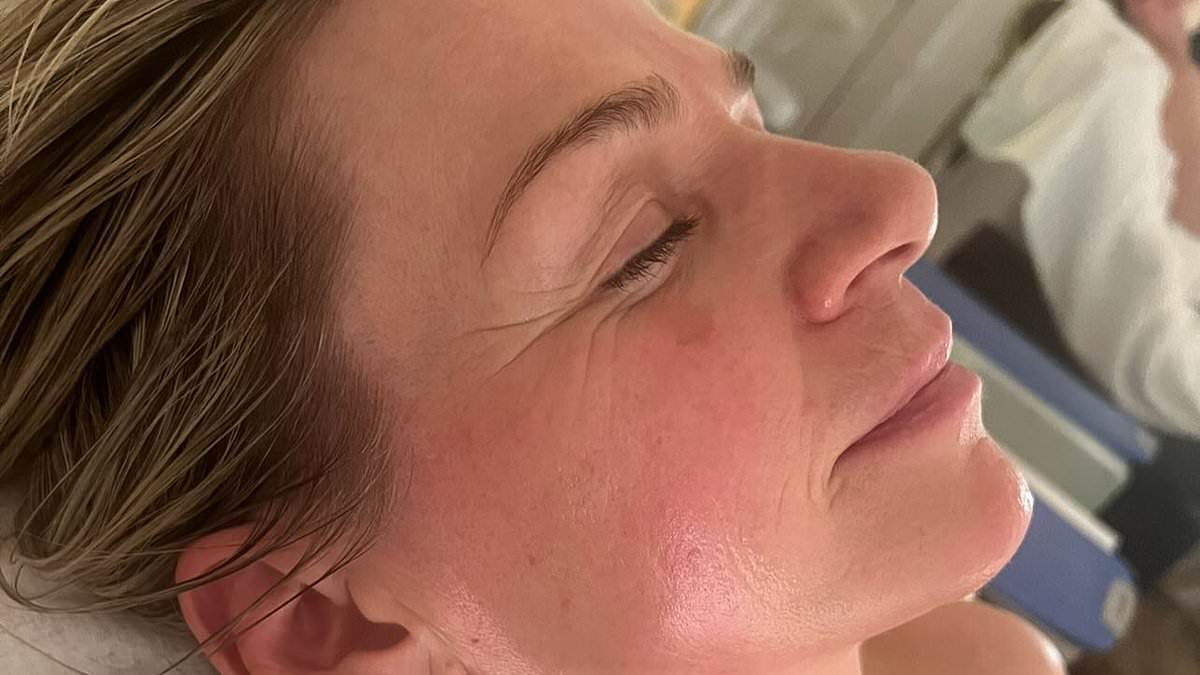Millions who suffer debilitating migraines may actually have a widely overlooked muscle condition, say experts – and there’s a simple fix that DOESN’T involve drugs
By Editor,Zoe Hardy
Copyright dailymail

A common, easily treated muscle disorder may be fuelling the debilitating migraine attacks suffered by millions, experts say.
Temporomandibular disorder (TMD) affects the movement of the jaw joint and can cause pain that radiates to the ears, temples and across the face – often triggering tension headaches, sleepless nights and even migraine attacks.
It is thought to affect around one in 15 adults in the UK – including presenter Zoe Ball – yet is often overlooked. Research shows one in five people with TMD also suffer migraines or regular headaches.
An estimated ten million Britons are affected by migraines, the most common headache disorder worldwide.
Attacks – often an unbearable throbbing pain on one side of the head – can last from two hours to three days and are typically accompanied by extreme fatigue, nausea, mood changes and sensitivity to light.
Until now, migraines have largely been seen as incurable, with sufferers told to manage symptoms through painkillers, lifestyle changes and by avoiding triggers such as stress, alcohol, caffeine and teeth-grinding.
For many, however, attacks continue, often becoming chronic and severely disrupting daily life.
According to Dr Justin Durham, consultant oral surgeon and professor of orofacial pain at Newcastle University, a common but treatable trigger is too often missed: TMD.
‘The condition is phenomenally common,’ he says. ‘Some people have little or no jaw pain or headache, while others are left with debilitating migraines. These symptoms can be extremely painful and distressing, which can leave sufferers fearing the worst when really there could be a simple explanation.’
There are two main types of headache linked to TMD: tension-type headaches, characterised by a constant dull ache on both sides of the head, and migraines, which tend to be more severe and one-sided.
The good news, according to Dr Durham, is that in most cases TMD – and therefore TMD-related migraines – can be treated at home.
‘There is a complex tapestry of things that can be done before considering medication,’ he says.
‘If you can master your sleep schedule, diet, hydration and exercise, and identify patterns that make your TMD flare, you can manage symptoms effectively.’
TMD itself is not one single illness but a group of problems affecting the jaw joint, the muscles that move it and the surrounding tissues.
It can cause pain, stiffness, headaches and difficulty opening or closing the mouth. The temporomandibular joint acts like a hinge, linking the jaw to the skull and allowing us to chew, speak and yawn.
There is rarely a single cause. Injury, arthritis, hormones and day-to-day triggers such as stress, poor sleep or too much caffeine can all play a role- and may in turn spark a migraine.
Experts believe this is because jaw pain and migraine pain travel along the same nerve networks in the head, meaning one can set off or intensify the other.
‘The body’s pain system is like the electrical wiring in a house and your brain is the fuse board,’ says Dr Durham. ‘TMD and migraine are on the same switch. If you fire one up, it’s not a surprise the other follows.’
Nyree Whitley, chief clinical officer at dental chain mydentist, adds: ‘When the joint and its muscles are irritated or overworked from clenching, grinding or misalignment, the joint becomes inflamed.
‘This can trigger the trigeminal nerve in the face, sending pain signals to the head, temples and behind the eyes.’
Former Radio 2 presenter Zoe Ball has also spoken about her struggles with TMD, which she said left her in ‘horrendous pain’.
In November, shortly after announcing she was stepping down from her breakfast show, the 54-year-old revealed she ‘wakes most days with awful headaches’ caused by jaw clenching and tension linked to the condition.
Ball has undergone a range of treatments, including Botox injections into her jaw muscles and a facial massage designed to ease muscle tightness. She has also relied on simple at-home remedies such as hot and cold compresses.
Sharing before-and-after photos of treatment at a London clinic, she thanked the therapist – ‘Helen @thesculptresslondon … for her magic’ – and showed how her face looked more relaxed afterwards.
According to Dr Durham, the most effective first step in treatment is tracking symptoms to identify possible triggers. Stress, for example, may not directly cause TMD but can worsen it.
‘There are things you can do to calm the body’s pain response,’ he says. ‘Exercise, mindfulness and prioritising sleep all help.’
Making small lifestyle changes in response to personal triggers – whether that’s cutting back on alcohol, drinking less caffeine or sticking to a regular bedtime – can make a dramatic difference, he adds.
Longstanding data suggests that if these steps are taken early and consistently, up to 95 per cent of people improve, slashing the risk of TMD-related migraines.
Other self-management techniques include eating softer foods for around ten days, applying heat or ice packs, jaw exercises, relaxation techniques and physical therapy.
If symptoms persist, experts say patients should seek help from their GP or dentist, particularly if the pain is jaw-specific.
Newer treatments include drugs called CGRP inhibitors, which block pain-carrying proteins in the brain and have shown promise in easing both migraine and TMD-related symptoms.
Botulinum toxin injections, such as Botox – which Zoe Ball has said help her – are also being trialled.
Already used successfully in chronic migraines, researchers believe they may also ‘turn down’ pain signals from the jaw joint.
Botox is available on the NHS for chronic migraines, but not for jaw disorders such as TMD, meaning many patients who seek it for jaw pain pay privately.
Dr Durham is spearheading the world’s largest trial of injectable treatments for TMD, in the hope of finding better options for those who do not get relief from lifestyle measures or existing medication.
‘These conditions can be really debilitating,’ he says. ‘But remember, TMDs are common and manageable. They can cause great pain, but they rarely cause lasting damage.



